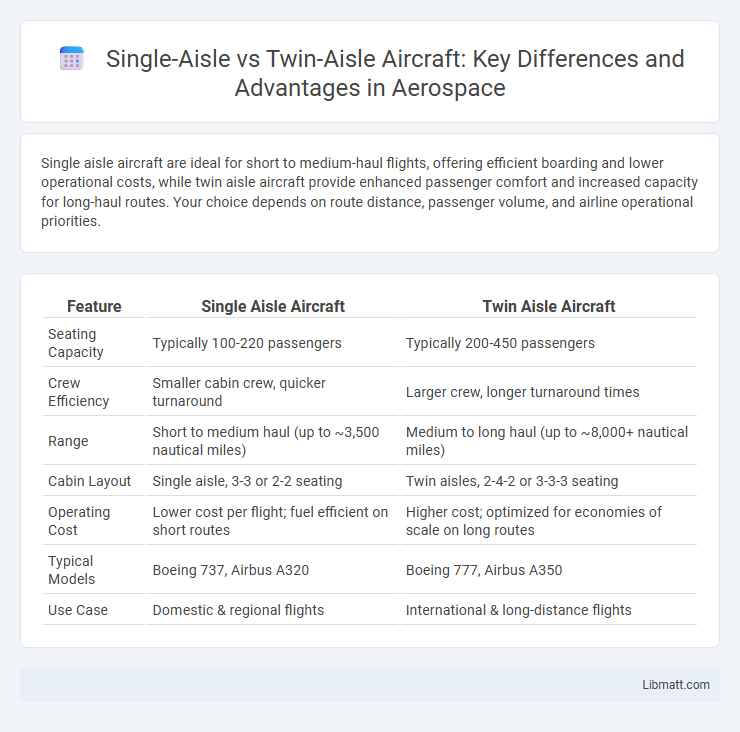Single aisle aircraft are ideal for short to medium-haul flights, offering efficient boarding and lower operational costs, while twin aisle aircraft provide enhanced passenger comfort and increased capacity for long-haul routes. Your choice depends on route distance, passenger volume, and airline operational priorities.
Table of Comparison
| Feature | Single Aisle Aircraft | Twin Aisle Aircraft |
|---|---|---|
| Seating Capacity | Typically 100-220 passengers | Typically 200-450 passengers |
| Crew Efficiency | Smaller cabin crew, quicker turnaround | Larger crew, longer turnaround times |
| Range | Short to medium haul (up to ~3,500 nautical miles) | Medium to long haul (up to ~8,000+ nautical miles) |
| Cabin Layout | Single aisle, 3-3 or 2-2 seating | Twin aisles, 2-4-2 or 3-3-3 seating |
| Operating Cost | Lower cost per flight; fuel efficient on short routes | Higher cost; optimized for economies of scale on long routes |
| Typical Models | Boeing 737, Airbus A320 | Boeing 777, Airbus A350 |
| Use Case | Domestic & regional flights | International & long-distance flights |
Overview of Single Aisle and Twin Aisle Aircraft
Single aisle aircraft, commonly referred to as narrow-body planes, typically seat between 100 to 240 passengers and are designed for short to medium-haul flights, offering efficiency and lower operating costs. Twin aisle aircraft, or wide-body jets, accommodate 250 to over 600 passengers, equipped with two aisles to enhance passenger boarding and comfort, making them suitable for long-haul international routes. The main differences lie in cabin width, passenger capacity, range, and operational focus, with single aisles optimized for domestic and regional travel and twin aisles engineered for intercontinental service.
Key Design Differences
Single aisle aircraft typically feature a narrow fuselage with one central aisle, optimizing them for short to medium-haul routes and faster boarding times. Twin aisle aircraft, also known as wide-body planes, have a wider fuselage with two aisles, allowing more passenger capacity and enhanced cabin comfort on long-haul flights. Key design differences include fuselage width, seating arrangement, structural weight, and range capabilities tailored to their specific operational roles.
Passenger Capacity and Seating Layout
Single aisle aircraft typically accommodate between 100 and 240 passengers with seating in a 3-3 or 2-2 configuration, optimizing short to medium-haul routes. Twin aisle aircraft, designed for long-haul flights, offer significantly higher passenger capacity, ranging from 250 to over 600 seats, arranged in 2-4-2 or 3-3-3 layouts to enhance onboard comfort and accessibility. The seating layout in twin aisle planes supports wider cabins and multiple aisles, facilitating easier passenger movement and efficient boarding processes.
Range and Operational Capabilities
Single aisle aircraft, such as the Boeing 737 and Airbus A320 families, typically offer ranges between 3,000 to 4,000 nautical miles, making them ideal for short to medium-haul routes and high-frequency regional operations. Twin aisle aircraft, including models like the Boeing 777 and Airbus A350, provide extended ranges exceeding 7,000 nautical miles, supporting long-haul international flights with enhanced passenger capacity and comfort. Operational capabilities differ as single aisle planes enable quicker turnaround times and access to smaller airports, while twin aisle jets focus on efficiency and performance over longer distances with larger payloads.
Fuel Efficiency Comparison
Single aisle aircraft generally exhibit higher fuel efficiency per seat on short to medium-haul routes due to their lighter weight and optimized aerodynamics. Twin aisle aircraft, designed for longer distances with larger passenger capacities, tend to have higher fuel consumption but benefit from economies of scale on extensive flights. Advances in engine technology and materials continue to narrow the fuel efficiency gap between single aisle and twin aisle aircraft.
Airport Compatibility and Turnaround Times
Single aisle aircraft are better suited for airports with limited gate space and shorter taxiways due to their compact size, allowing quicker turnaround times that enhance operational efficiency. Twin aisle aircraft require larger airport infrastructure and more extensive ground handling resources, which can extend turnaround times and reduce slot flexibility. Understanding your airport compatibility will optimize scheduling and improve overall fleet utilization.
Cost of Acquisition and Maintenance
Single aisle aircraft generally have lower acquisition costs, typically ranging between $50 million and $120 million depending on the model, while twin aisle aircraft can exceed $200 million due to their size and complexity. Maintenance expenses for single aisle planes are also more economical, driven by simpler systems and fewer engines, resulting in lower labor and parts costs. Twin aisle aircraft incur higher maintenance costs, often up to 40% more annually, given advanced avionics, increased engine numbers, and more extensive structural components.
Suitability for Different Routes
Single aisle aircraft excel on short to medium-haul routes due to their efficient boarding and quicker turnaround times, making them ideal for regional and domestic flights. Twin aisle aircraft suit long-haul and high-capacity routes, providing enhanced passenger comfort, additional cabin space, and increased fuel efficiency over extended distances. Your choice depends on route distance, passenger volume, and airline operational needs.
Passenger Experience and Comfort
Single aisle aircraft typically offer quicker boarding and disembarking, ideal for short to medium-haul flights, but may provide limited legroom and narrower seats compared to twin aisle planes. Twin aisle aircraft enhance passenger comfort with more spacious cabins, wider seats, and better aisle access, reducing congestion and allowing easier movement during longer journeys. Your choice impacts in-flight experience, with twin aisle planes generally preferred for comfort on extended flights while single aisle aircraft suit efficiency and shorter travel times.
Future Trends in Aircraft Development
Future trends in aircraft development emphasize lightweight materials, improved fuel efficiency, and enhanced passenger comfort for both single aisle and twin aisle models. Single aisle aircraft continue to evolve with advanced aerodynamic designs and next-generation engines to optimize regional and short-haul operations, while twin aisle aircraft integrate larger cabins, increased range, and sustainable technologies to meet long-haul demands. Investment in electric propulsion and hybrid systems is reshaping the aerospace industry, targeting reduced carbon emissions and operational costs across all aircraft categories.
Single Aisle vs Twin Aisle Aircraft Infographic

 libmatt.com
libmatt.com